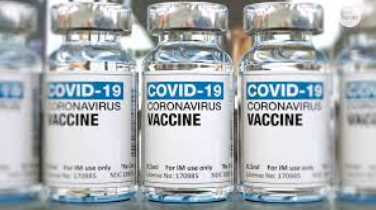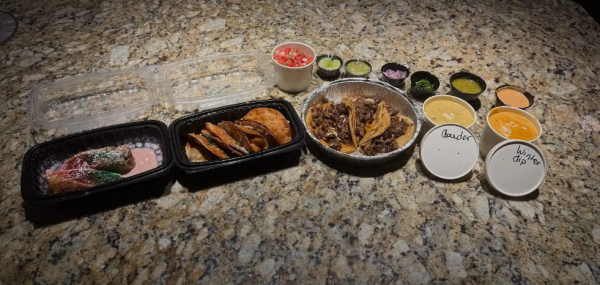What the COVID-19 vaccine entails

Image from ydr.com
The COVID-19 vaccine is here, and there is finally some sort of light at the end of the tunnel. The past year has been a year that no one will forget. Many people have gone and are still going through ups and downs, through losses to COVID, and struggle with mental health. Besides 2020, the new year is finally here and it is kicking off with the COVID vaccine. Though things are still different, there still might be something for people to look forward to while people continue this year.
Some may worry about what the vaccine contains, so here are the following ingredients. According to the FDA the covid vaccine includes: mRNA, lipids ((4-hydroxybutyl)azanediyl)bis(hexane-6,1-diyl)bis(2-hexyldecanoate), 2 [(polyethylene glycol)-2000]-N,N-di-tetradecyl acetamide, 1,2-Distearoyl-sn-glycero-3- phosphocholine, and cholesterol), potassium chloride, monobasic potassium phosphate, sodium chloride, dibasic sodium phosphate dihydrate, and sucrose. Even though there are many ingredients, all the ingredients have scientific evidence to back up why they are included. The following information is found at cdc.gov. It is an mRNA vaccine, meaning the people receiving the vaccine are not directly getting the virus. Instead, the vaccine has a specific protein called “spike protein” that is from the virus’s top layer. To put it into easier terms, once the protein is released into the body, the immune system will recognize it as a threat to its system and create antibodies to fight against the protein. The newly formed antibodies can now recognize the virus and kill it before it will do further damage to the body.
The vaccine is not the same as other vaccines in the past due to it using an mRNA formatting, and taking proteins directly from the virus, and implanting it into the vaccine. When the vaccination is given, directly injects the viral proteins into the body instead of inactive amounts of the virus. This technique is much more advanced and innovative than in years past.
Before all of this was available to most of the public it had to go through many vigorous steps for approval. Once the viral vaccine has been completed with the beginning of the research phases, the organizers have to gather all of the information from their studies and submit it to the FDA for approval for the next step. The FDA will then make sure all of the research and the process of the research in the labs is up to date with all of their guidelines. This includes the evaluation of all the data if the tests run in labs were run within the lab practice guidelines, if the product is good and safe quality, and if it was developed within a safe manufacturing system. If all of the research has met the criteria for all of these guidelines, the FDA will approve it for its next step, which is finally testing on humans.
According to the FDA, during human trials, there are three phases that it must go through to pass the next step. The first trial consists of a really small group of about a hundred participants. These volunteers are a group that fit the “healthy category” and were not yet affected by the virus. The next phase is with a much larger group that contains different races, sex, health issues, and most age groups. Once the second phase is completed the third phase will begin. They will test around a thousand people to see what will be the most controlled and non-controlled outcomes from the vaccine. Once all three phases are completed, there is one more step.

According to the FDA, in the last step, the manufacturing company producing the vaccines must submit a BLA that must be approved by the FDA. BLA stands for Biologics License Application, the application allows manufacturing companies to produce and distribute the vaccine legally. The FDA does state that even though the vaccine has been approved, it is always undergoing more tests and trials to make sure it is always safe and up to date.
Based upon the FDA, after the testing phases are completed, and the vaccine has been approved for public use and distribution, the FDA has to expedite the speed since it is a pandemic. They work with pharmacies across the country and the government to speed up the process. They try to create the best plan for the situation at hand so that they can take action and move forward with administering the vaccine to the public.
According to AARP, the vaccine was being distributed to the front-line workers such as people working in healthcare, grocery stores, schools, police officers, firefighters, and people of the age of 75 or higher. The vaccine may be available for other groups, but these are the few.
When receiving the vaccine the person will receive two doses of the shot through the upper arm muscle. The shots are spaced out in order for the whole process to be effective (FDA.com). The shots are spaced out between a three to a four week time span (AP.com).
As chaotic and long this process may sound, it will hopefully help the virus subside and decrease in numbers, into which there will be a time in the future/ near future where things can be normal again. For the time being, the best thing to do is to be optimistic and put trust in the vaccine, and that its process will work in time.
FDA., editor. “Vaccine Development-101.” FDA, 14 Dec. 2020, www.fda.gov/
vaccines-blood-biologics/development-approval-process-cber/
vaccine-development-101. Accessed 14 Dec. 2020.
Cdc, editor. “Understanding mRNA COVID-19 Vaccines.” CDC, 18 Dec. 2020,
www.cdc.gov/coronavirus/2019-ncov/vaccines/different-vaccines/mrna.html.
Accessed 18 Dec. 2020.
FDA. Dec. 2020, www.fda.gov/media/144414/
download#:~:text=The%20Pfizer%2DBioNTech%20COVID%2D19%20Vaccine%20includes%20the%20following%20ingredients,)%2C%20potassium%20chloride%2C%20monobasic%20potassium.Accessed Dec. 2020.
Fda, editor. “Biologics License Applications (BLA) Process (CBER).” FDA, 20 Nov.
2020, www.fda.gov/vaccines-blood-biologics/
development-approval-process-cber/
biologics-license-applications-bla-process-cber. Accessed 20 Nov. 2020.
Bunis, Dena, editor. “Phase 1a, 1b or 1c? Understanding Coronavirus Vaccine
Priority Groups.” AARP, 21 Dec. 2020, www.aarp.org/health/
conditions-treatments/info-2020/covid-vaccine-priority-groups.html.
Accessed 21 Dec. 2020.
Cdc, editor. “Frequently Asked Questions about COVID-19 Vaccination.” CDC, 29
Dec. 2020, www.cdc.gov/coronavirus/2019-ncov/vaccines/faq.html. Accessed 29
Dec. 2020.
Neergaard, Lauran, editor. “EXPLAINER: US Regulator Weighs in on Vaccine Dosing
Debate.” AP News, 4 Jan. 2021, apnews.com/article/
Vaccine-dosing-debates-confusion-explain-b9e3e910d0e0f0b696a7c7c278287be9.
Accessed 4 Jan. 2021.
Your donation will support the student journalists of Parkland High School. Your contribution will allow us to purchase equipment and cover our annual website hosting and printing costs.







